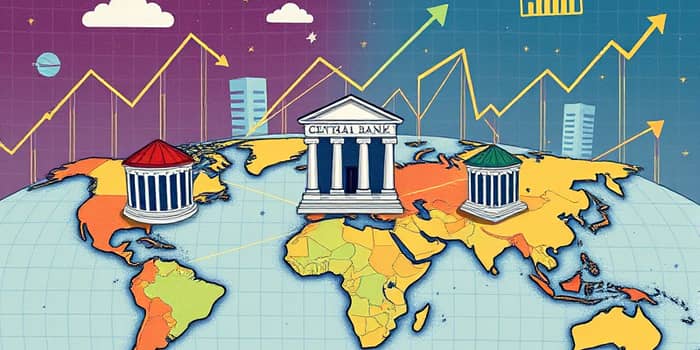
In 2025, central banks navigate a fragmented global policy landscape, balancing the aftermath of the pandemic with new economic shocks. As governments grapple with elevated tariffs, demographic changes and uneven recoveries, monetary authorities adjust strategies to sustain growth and anchor inflation expectations. Investors and policymakers alike must decipher these shifts to chart resilient paths forward.
Across regions, monetary frameworks diverge in response to local conditions. Some economies face persistent slack in labor markets, while others wrestle with overheating. Central banks that once marched in lockstep are now pursuing tailored strategies.
The United States Federal Reserve remains cautious on rate cuts, citing above-target inflation pressures and evolving labor metrics. By contrast, the Reserve Bank of Australia, buoyed by moderating price rises, has already eased policy twice in early 2025.
In August 2025, the Fed completed its five-year strategy review, issuing a revised Statement on Longer-Run Goals and Monetary Policy Strategy. Key modifications include dropping language on averaging inflation over time and reaffirming a strict two percent inflation target. The definition of maximum employment was updated to the “highest level that can be achieved on a sustained basis in the context of price stability.”
The Fed also introduced a “balanced approach” when employment and price stability goals conflict and acknowledged that employment can exceed maximum levels temporarily without risking inflation. This shift underscores a more flexible framework, prioritizing forceful action to anchor expectations against rising prices.
At its October 2025 meeting, the FOMC cut the federal funds rate by 25 basis points to 3.75–4.00%. Market participants anticipate further reductions, potentially ending the year around 3.00%, with that pace accelerating in 2026. The current PCE inflation projection stands at 3.1% for 2025 and is expected to ease to 2.4% in 2026. Unemployment forecasts have ticked up to 4.5%, versus previous estimates of 4.3%.
Divergent views within the FOMC surfaced, with one member advocating a 50-basis-point cut and another opposing any easing. Such debates reflect the uncertain outlook for growth and prices as policymakers weigh risks carefully.
Beyond traditional models, nonmonetary factors are reshaping policy discourse. Fed Governor Stephen Miran argues that declining immigration and an aging population have trimmed the neutral rate (r*) by roughly 0.4 percentage points. He calls for integrating these structural trends into policy analysis, challenging reliance on rules like the Taylor Rule.
Simultaneously, proposed reforms threaten to dilute Fed independence. Suggestions for shorter governor terms and expanded presidential dismissal powers have raised alarms among analysts who warn of potential politicization and credibility erosion. Such changes could introduce volatility into markets and undermine the Fed’s ability to combat inflation impartially.
Project 2025 outlines a suite of radical proposals, invoking debates over the future shape of U.S. monetary policy:
Advocates argue these measures would constrain inflation and restore market discipline, while critics caution they could inflict severe economic dislocations and heighten systemic risk.
The RBA has leveraged a window of moderating inflation to cut rates twice in the first half of 2025. Future easing is expected, but officials emphasize a cautious and data-driven approach amid global uncertainty.
Other regions exhibit varied dynamics: emerging markets face currency pressures and commodity volatility, whereas advanced economies in Europe contend with labor shortages and fiscal headwinds. These divergences underscore the necessity of context-specific strategies rather than one-size-fits-all policies.
Monetary shifts reverberate across markets. Lower rates tend to favor growth-oriented equities but can compress financial sector margins. Investors must assess sector sensitivities and adjust exposure accordingly.
In this shifting environment, flexible, hedged investment strategies are paramount. Portfolios should blend cyclical and defensive assets, balancing growth opportunities with protection against sudden policy reversals.
Hedging tools such as options and currency forwards can mitigate downside risks. Meanwhile, maintaining liquidity buffers allows investors to respond swiftly to unexpected central bank announcements or geopolitical shocks.
Ongoing debates over the Fed’s independence reflect broader tensions between democratic accountability and technocratic expertise. Efforts to expand political oversight risk undermining the institutional credibility necessary for effective inflation control.
Markets prize predictability and trust that central banks will act based on economic data rather than political imperatives. Any erosion of this trust could amplify volatility and complicate the transmission of monetary policy.
As central banks recalibrate tools and mandates, investors and businesses must stay vigilant. Understanding the nuanced trade-offs between employment and price stability will guide informed decisions in portfolios and strategies.
By monitoring regional divergences, structural trends and political developments, stakeholders can craft resilient approaches. In an era of rapid change, success hinges on agility, research-driven insights and a clear-eyed view of the evolving monetary framework.
References





